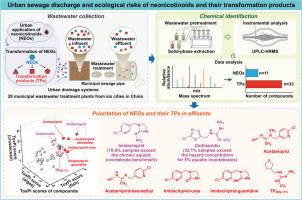当前位置:
X-MOL 学术
›
Water Res.
›
论文详情
Our official English website, www.x-mol.net, welcomes your
feedback! (Note: you will need to create a separate account there.)
Urban sewage discharge of neonicotinoids and their transformation products threatens aquatic organisms
Water Research ( IF 11.4 ) Pub Date : 2024-11-02 , DOI: 10.1016/j.watres.2024.122740 Yingying Yang, Qing Zhang, Yilin Xiao, Yu Xiao, Hui Gao, Shangwei Zhang, Adrian Covaci, Xinghui Xia
Water Research ( IF 11.4 ) Pub Date : 2024-11-02 , DOI: 10.1016/j.watres.2024.122740 Yingying Yang, Qing Zhang, Yilin Xiao, Yu Xiao, Hui Gao, Shangwei Zhang, Adrian Covaci, Xinghui Xia

|
Neonicotinoid insecticides (NEOs) are frequently used for urban landscape management and vector control, and undergo various transformation processes when release into urban environments. The discharges of NEOs and their transformation products (TPs) from urban sewer networks may pose serious threats to freshwater ecosystem integrity. However, TPs of NEOs present in municipal wastewater treatment plants (MWWTPs) and their associated risks to aquatic organisms are largely unknown. Here, we investigate NEOs and their TPs in 28 MWWTPs of six Chinese cities. Eleven NEOs and 33 TPs were identified, and 17 TPs were firstly detected in environmental medium. Considerable concentrations of NEOs and their TPs (17.0–1543 ng/L) were measured in the effluents, and two NEOs exceeded the ecological quality reference values in 32.1% (for clothianidin) and 78.6% (for imidacloprid) of the effluents. Simultaneously, 12 TPs had a higher regulatory priority than the corresponding NEOs in at least one aquatic organism using a toxicological priority index. Furthermore, 79.5% of NEOs and their TPs exhibited high persistence and mobility, and thus these compounds could readily spread over long distances in aquatic environment. This study highlights that the input of NEOs and their TPs from treated wastewater into aquatic ecosystem should be regulated to mitigate the ecological risks.
更新日期:2024-11-02


















































 京公网安备 11010802027423号
京公网安备 11010802027423号